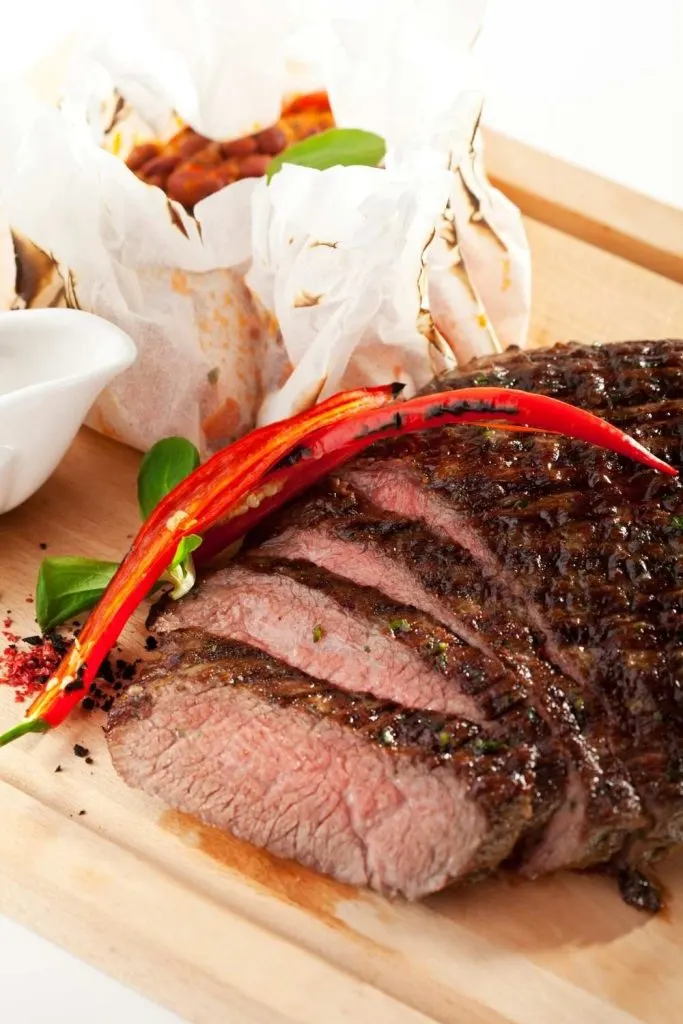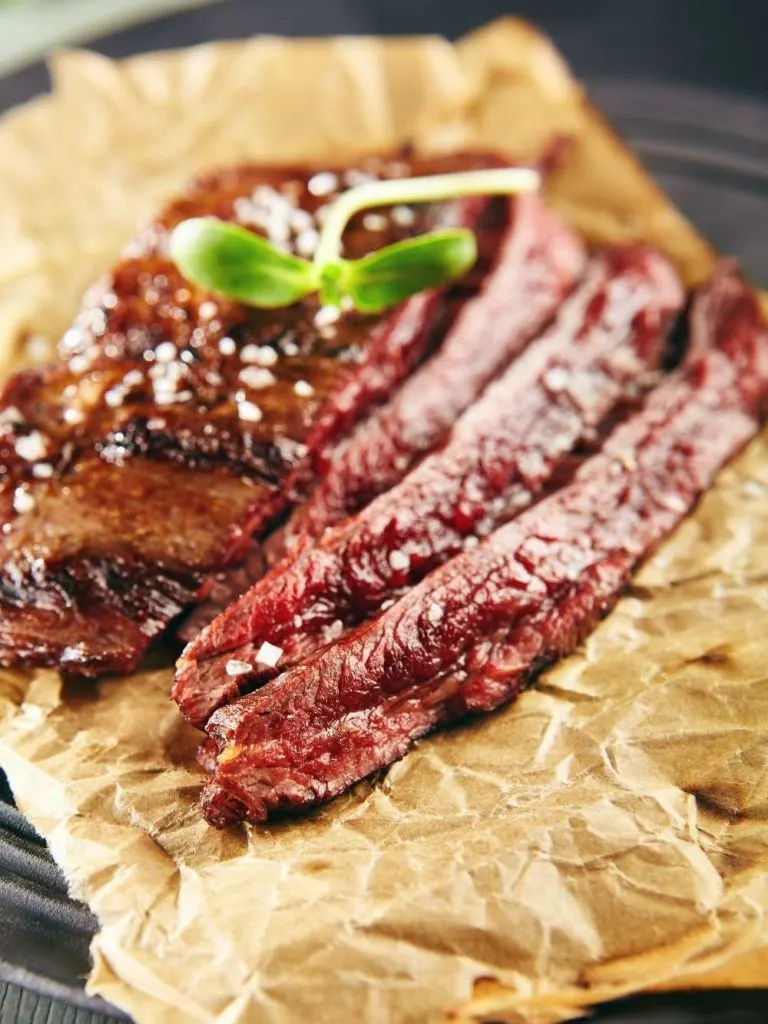Marinating the flank steak in this Ina Garten recipe results in a steak that is so delicate and juicy that it practically melts in your mouth, with a rich flavor profile that includes salty, acidic, sweet, and spicy overtones. The steak is soaked in a marinade of soy sauce, balsamic vinegar, lemon juice, brown sugar, and spices.

The most delicious component of a grilled flank steak? Easy peasy, and there’s no mess to be found! Simply marinate and grill the meat, and you’re good to go. (I also provided stovetop and oven directions.) Flank steak may be served with a wide variety of sides, including mashed potatoes and fruit salad, or it can be used as the main ingredient in a variety of dishes, including salads, wraps, pasta, sandwiches, and more.
What Is Flank Steak?
Briefly, flank steak is a piece of meat that originates in the cow’s abdomen muscle. It has a deep meaty taste despite being exceedingly lean and muscular. Approximately a foot in length, with a thickness of less than an inch and highly noticeable grains, flank steak is a long, flat cut of beef.
Marinating a tough piece of beef, like flank steak, makes it tender and tasty. Being best cooked rapidly at high temperatures makes it a go-to for grilling and stir-frying. What follows is a comprehensive guide to your next favorite beef dish.
What Does Flank Steak Taste Like?
Even though it is lean and lacks the rich marbling of more costly cuts of beef, flank steak boasts a powerful, deep meaty taste. However, flank steak might be on the rough side if not marinated properly. Whether you use soy sauce, Worcestershire sauce, vinegar, soy sauce, orange juice, lime juice, lemon juice, or orange juice, the meat will become soft and flavorful after being marinated. As long as the steak isn’t overcooked, it will be incredibly soft, juicy, and full of flavor.
Ina Garten Flank Steak Marinade Ingredients
- Olive Oil. For the finest flavor, be sure you use extra virgin olive oil of good quality.
- Soy Sauce. If you want to avoid giving your grilled flank steak a salty flavor, choose soy sauce with a lower sodium content.
- Balsamic Vinegar. For the finest flavor, use a balsamic vinegar of good quality.
- Worcestershire Sauce. Enhances the taste with a depth of nuanced umami and a hint of tang.
- Lemon Juice. The best option is freshly squeezed, but you may also use bottled.
- Brown Sugar. Provides a counterpoint to the sour lime juice and the rich umami flavor of the soy sauce.
- Dijon Mustard. I swear it won’t make your flank steak taste like mustard! It imparts a more complex sourness to the dish.
- Seasonings. In order to complete the taste profile, you will need basic seasonings such as paprika, pepper, red pepper flakes, dried oregano, dried rosemary, dried dill weed, and powdered coriander. You may omit the dried dill weed and ground coriander if you don’t have a supply of them, but I use both of those ingredients in a lot of other dishes, so I think it’s important to keep them on hand.
Can You Freeze Steak In The Marinade?
Another advantage of using airtight plastic bags for marinating meat is that you may store the steak in the freezer if you won’t be using it within 12 hours. Just defrost the flank steak when you’re ready to cook it!
What Goes With This Flank Steak?
The versatility of flank steak means that it may be served with a wide variety of sides and accompaniments. To really wow them, we like to serve them some of our favorite backyard BBQ delicacies. You may keep it as basic as chips and melons, or you can get fancier with macaroni salad, fruit salad, and grilled corn.
Listed below are a few of our preferred accompaniments for serving flank steak.
- Potluck Favorites. Corn casserole, grilled corn on the cob, elote (Mexican street corn), and baked macaroni and cheese round out the menu.
- Pasta Salad. The Greek Orzo Pasta Salad, the Italian Tortellini Salad, the BLT Pasta Salad, the Cowboy Pasta Salad, the Bacon and Pea Pasta Salad, and the traditional Italian Tortellini Salad.
- Potatoes. Potatoes in any form: mashed, smashed, roasted red, pesto, twice baked, scalloped, and mashed sweet potatoes.
- Fruit. Fruit salads with honey mascarpone, such as grilled pineapple, creamy grape salad, summer fruit salad, perfect fruit salad, tropical fruit salad, or berry salad.
- Bread. Choose from cornbread, garlic bread, breadsticks, dinner rolls, and Hawaiian rolls.
How To Make Ina Garten Flank Steak
- In a freezer-safe Ziploc bag, combine the marinade ingredients. 2 tablespoons are set aside for subsequent use. Seal by pressing out excess air and adding the meat. Massage the marinade into the beef with your hands through the bag.
- Marinate for at least 2 hours and up to 12 hours in the refrigerator.
- Heat an outdoor grill (or an indoor grill pan) to medium-high (450 degrees F when the lid is closed).
- Grill the steak for 5-6 minutes on each side, or until an internal thermometer reads 130-135°F for medium rare or approximately 140°F for medium. Grilling time may vary based on the thickness of your steak and the amount of doneness desired.
- Place the steak on a cutting board and set aside for 10 minutes before slicing. Thinly slice the steak against the grain (perpendicular to the long strands) or cut it into 1/2-inch cubes. Drizzle with the leftover marinade (2 teaspoons).

How Do I Know When Flank Steak Is Done?
Flank steak is a lean cut of beef that can become rough and chewy if overcooked. Medium pink is my goal. The marinade provides you some leeway, but don’t push it.
Depending on thickness and doneness, most steaks require 5-6 minutes on each side. Use an instant-read thermometer to check your flank steak for overcooking.
To check steak temperature, insert a quick read thermometer into the thickest section. Because steaks cook while resting, set the temperature to 5°F below the desired doneness.
- Rare Steak. 125 degrees F
- Medium Rare. 135 degrees F
- Medium. 145 degrees F *RECOMMENDED*
- Medium Well. 155 degrees F
- Medium Well. (not recommended)
- Well Done. 165 degrees F (not recommended)
Steaks and roasts should be cooked to 145 degrees Fahrenheit and allowed to rest for at least three minutes before serving, as per USDA guidelines. To get a rare or medium-rare steak, grill the meat over a high flame for just long enough to sear the exterior.
How To Cut Flank Steak?
Flank steak is notable for the direction in which the thick muscle fibers, or “the grain,” run through the steak. Steak is best cut across the grain (i.e., perpendicular to the grain) to shorten the fibers so that it cooks more quickly. This will prevent your flank steak from becoming chewy and instead make it extremely tender.
How To Serve Marinated Flank Steak?
Marinated flank steak is most often served as the main course alongside additional accompaniments. Take your pick of the aforementioned condiments and call it a meal. Flank steak, on the other hand, can be used in a variety of ways and tastes great in anything from salads to pasta to fajitas. If you’re bored with the same old grilled flank steak recipes, here are some creative alternatives.
- Flank Steak Salad. Choose your preferred greens and pile on some thinly sliced steak and your preferred vegetables, such as delicious grilled corn and peppers. Add some crunch with some buttered croutons and your preferred dressing (we recommend balsamic or blue cheese).
- Pasta With Flank Steak. Whether you’re making fettuccine alfredo, fettuccine sun-dried tomato, cacao e Pepe, creamy mushroom, pepper jack, mac and cheese, or homemade mac and cheese, chopped steak is a delicious addition. You can also use it as a substitute for beef in dishes like buffalo mac and cheese, beef stroganoff, and linguine with sun-dried tomato sauce. Flank steak goes well with low-carb side dishes like zoodles or spaghetti squash.
- Risotto With Flank Steak. Combining steak into risotto is a simple matter of adding chopped meat to the dish. Delicious risottos include the mushroom, parmesan, and spinach varieties.
- Pizza With Flank Steak. Imitating the style of CPK, prepare your favorite steak pizzas like the Philly Cheesesteak Pizza, Fajita Pizza, or Steakhouse Pizza with mushrooms, Gorgonzola, and microgreens. French bread or mini-pizzas made from bagels are two other quick pizza options.
- Flank Steak Grain Bowls. Mix your preferred grains with seared flank beef and your preferred vegetables and serve. Raw vegetables like fresh tomatoes, thinly sliced radishes, sprouts, etc.; cooked vegetables like roasted broccoli, cauliflower, Brussels sprouts, or butternut squash; pickled vegetables like pickled jalapenos, carrots, etc.; or a combination of all three! Additionally, you may add one egg, either fried or soft-boiled, as a topping.

Recipe Variations
- Swap Citrus. You may use lime juice or orange juice in place of lemon juice.
- Swap Vinegar. Make the substitution of red wine vinegar for balsamic.
- Swap Seasonings. Change the flavor profile by exchanging the seasonings called for in the recipe with cajun seasonings, fajita seasonings, or Asian-inspired ingredients like Chinese five spices, ginger, and garlic. This will give the dish a more complex and interesting taste.
- Add Some Heat To It. You may add more red pepper flakes, or you could substitute some cayenne or chipotle chili powder for the red pepper flakes.
- Add Chimichurri. Chimichurri is a fantastic complement to steak. The spicy, fresh cilantro and jalapeño chimichurri sauce that I use in my recipe for grilled pork comes highly recommended from me. It is the ideal accompaniment for the meaty and smokey flavor of the grilled steak.
How To Store Grilled Flank Steak?
- In The Fridge. Place the steak on the flank into an airtight container. Keep for up to five days in the fridge.
- In The Freezer. The steak should be allowed to cool fully after cooking before being transferred to a container or plastic freezer bag and the air squeezed out. Two to three months in the freezer.
- To Make Ahead. You can prepare a marinade for flank steak ahead of time, but the meat is tastiest when marinated right before being grilled. Marinate may be made up to five days in advance (without the steak) and stored in the refrigerator in an airtight container, provided it is stirred every day.
- To Reheat. Place steak slices on a microwave-safe dish. Heat in the microwave for one minute and check it. Prepare the flank steak by warming it in a pan over medium heat and turning it often until it is heated through.
My Personal Recipe Tips
There are some precautions to take while marinating a flank steak or any other type of meat to prevent the spread of disease. Just by adhering to a few easy guidelines, you can help ensure that your food is both clean and safe to eat.
- Use Food Safe Containers. To store food in the freezer, I like to use freezer Ziploc bags or other sealable plastic bags. They do an excellent job of letting the marinade permeate the steak. This is a dish where the steak may or may not be completely marinated. If you’re going to use a plastic bag to transport your steak, make sure to remove any excess air before you close it, and then wrap the bag up to form a snug container. Use a sealable bag and you can just trash it after use. If you don’t have any containers with lids, you can use glass, stainless steel, or plastic that is safe for food.
- Flip Steak Occasionally. To ensure that the flank steak marinates evenly, turn it over periodically if marinating in a shallow dish.
- Marinate In The Refrigerator. In order to prevent food poisoning, the steak should never be marinated at room temperature but rather under refrigeration for an extended length of time. So that it grills evenly, take it out of the fridge and set it on the counter 60 minutes before you want to cook it.
- The Marinade Should Not Be Used Again. Marinades should never be used again, not even for basting, unless they have been boiled to kill any bacteria. Before adding the steak to the marinade, save aside some of the marinade to use for basting, drizzling, or dipping. It’s something I do in practically all of my recipes, including this one.
- Pro Tip. A few teaspoons of the unused marinade may be used to add more flavor to vegetables before grilling or frying, as I do in my chicken fajita recipe and in many kabob dishes.
Try More Recipes:
Ina Garten Flank Steak Nutrition Facts
Amount Per Serving
- Calories 183
- Total Fat 11g
- Saturated Fat 3g
- Cholesterol 34mg
- Sodium 2887mg
- Total Carbohydrate 1g
- Dietary Fiber 0g
- Protein 19g
Nutrition Facts Source: Source

Ina Garten Flank Steak
Description
Marinating the flank steak in this Ina Garten recipe results in a steak that is so delicate and juicy that it practically melts in your mouth, with a rich flavor profile that includes salty, acidic, sweet, and spicy overtones. The steak is soaked in a marinade of soy sauce, balsamic vinegar, lemon juice, brown sugar, and spices.
Ingredients
Instructions
- In a freezer-safe Ziploc bag, combine the marinade ingredients. 2 tablespoons are set aside for subsequent use. Seal by pressing out excess air and adding the meat. Massage the marinade into the beef with your hands through the bag.
- Marinate for at least 2 hours and up to 12 hours in the refrigerator.
- Heat an outdoor grill (or an indoor grill pan) to medium-high (450 degrees F when the lid is closed).
- Grill the steak for 5-6 minutes on each side, or until an internal thermometer reads 130-135°F for medium rare or approximately 140°F for medium. Grilling time may vary based on the thickness of your steak and the amount of doneness desired.
- Place the steak on a cutting board and set aside for 10 minutes before slicing. Thinly slice the steak against the grain (perpendicular to the long strands) or cut it into 1/2-inch cubes. Drizzle with the leftover marinade (2 teaspoons).
Notes
- Use Food Safe Containers. To store food in the freezer, I like to use freezer Ziploc bags or other sealable plastic bags. They do an excellent job of letting the marinade permeate the steak. This is a dish where the steak may or may not be completely marinated. If you’re going to use a plastic bag to transport your steak, make sure to remove any excess air before you close it, and then wrap the bag up to form a snug container. Use a sealable bag and you can just trash it after use. If you don’t have any containers with lids, you can use glass, stainless steel, or plastic that is safe for food.
- Flip Steak Occasionally. To ensure that the flank steak marinates evenly, turn it over periodically if marinating in a shallow dish.
- Marinate In The Refrigerator. In order to prevent food poisoning, the steak should never be marinated at room temperature but rather under refrigeration for an extended length of time. So that it grills evenly, take it out of the fridge and set it on the counter 60 minutes before you want to cook it.
- The Marinade Should Not Be Used Again. Marinades should never be used again, not even for basting, unless they have been boiled to kill any bacteria. Before adding the steak to the marinade, save aside some of the marinade to use for basting, drizzling, or dipping. It’s something I do in practically all of my recipes, including this one.
- Pro Tip. A few teaspoons of the unused marinade may be used to add more flavor to vegetables before grilling or frying, as I do in my chicken fajita recipe and in many kabob dishes.
Servings 5
- Amount Per Serving
- Calories 183
- % Daily Value *
- Total Fat 11g17%
- Saturated Fat 3g15%
- Cholesterol 34mg12%
- Sodium 2887mg121%
- Total Carbohydrate 1g1%
- Dietary Fiber 0g
- Protein 19g38%
* Percent Daily Values are based on a 2,000 calorie diet. Your daily value may be higher or lower depending on your calorie needs.

